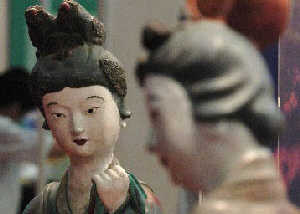Other figures in the temple include four eunuchs and a few female servants in men's clothes. The rest are all women servants wearing clothes of the lateTang Dynastyand the followingFive Dynasties; some are in long robes, some in short shirts and long skirts. Their hair is combed into coils of different shapes and colorful scarves cover their heads. Each of them holds tools or writing materials, and they are either dressing for their masters, serving their dinners, singing and dancing to amuse them or preparing their beds. Their expressions and gestures are natural and, peaceful.

The female servant sculptures in the Jin Temple represent women of different temperament and personality. Some are smiling and greeting each other, some are whispering with each other; all, however, have fine features and calm expressions. These sculptures were carved so vividly that one can almost feel their breath and their pulse and hear their whispered words. They reflect women's lives and feelings in the Song Dynasty. From them we see that Song Dynasty sculptors paid great attention to revealing the inner world of their figures.
The Superb skills of Song Dynasty sculptors can also be seen in the sculptures' drapery The Goddess' robe appears to have a soft and delicatequality and it falls in harmony with her body structure. The designs on the servants' skirts are beautifully patterned; andjadependants attached to some of the scarves and belts symbolize the wearers' different status and to make the figures appear more diversified. The colored sculpture group in the Jin Temple reveals a harmonious relationship between masters and servants. The Goddess must be a very kind and lovely lady and all her clever and virtuous servants were loyal to her; together they present a very touching scene.
